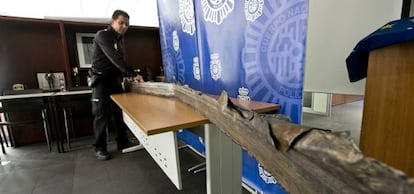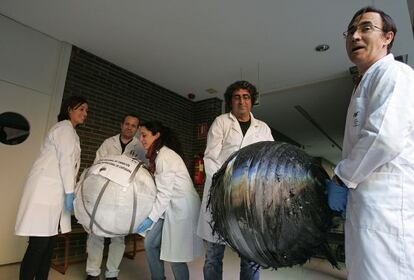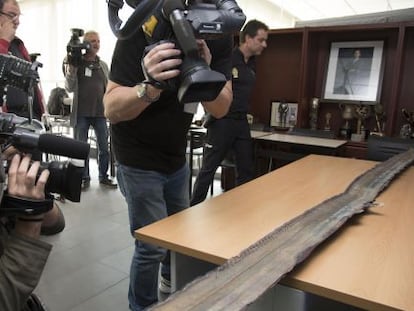The trash that falls from the sky
Scientists keep a close eye on the thousands of pieces of space debris floating near Earth The objects found in Spain in recent days may have come from secret devices, they suspect

Uncontrolled re-entries of large space objects of the kind recently found in eastern Spain occur around once a week, explains Holger Krag, head of the Space Situational Awareness department at the European Space Agency (ESA).
“But they are not dangerous to the population because most of the Earth’s surface is water and large portions of land are not densely populated,” he notes.
“The likelihood of getting hit by one of those fragments is much lower than being hit by lightning.”
There are no known cases of injuries from space trash”
Miguel Belló-Mora, managing director of Elecnor Deimos
Yet the three objects that fell in in rural parts of Mula and Calasparra (both in Murcia) and in Elda (Alicante) in recent days did not burn up upon re-entry – a fact that intrigues specialists.
Experts already know that the two hollow spheres covered in carbon fiber that crashed in Murcia are fuel deposits, probably from a space launch vehicle or an orbiting artifact.
They also suspect that they might have come from some kind of classified military device.
“These objects were not listed,” says Noelia Sánchez, a specialist at Elecnor Deimos, a technology company that works with the aerospace and defense sectors. “We cannot find them on the list of over 20,000 fragments of space debris larger than five to 10 centimeters that we already know about and are monitoring.”
The ESA’s Space Situational Awareness program keeps an eye on artificial objects in orbit around the Earth, using radar and telescopes.

“We want to draw up a constantly updated list of the 20,000 to 30,000 largest space debris objects, and this catalogue can then be used to predict their re-entry and their proximity to operating satellites,” writes Krag in an email from the ESA’s operating center in Damstadt (Germany).
In keeping with this European effort, Elecnor Deimos has recently inaugurated a battery of telescopes in Puertollano (Ciudad Real) to monitor space trash.
Scientists knew, for example, that an object identified as WT1190F was scheduled to fall in the Indian Ocean, south of Sri Lanka, at 7.20am Spanish time on Friday. This object was following an erratic orbit, though it was unclear whether it was a meteorite or a fragment from a piece of equipment used on an old Moon exploration mission.
But until a European catalogue is drawn up, international experts will have to continue to rely on the list of space debris compiled by the United States, which may omit the existence of fragments of secret military artifacts if it deems it necessary.
Space debris poses a risk to orbiting satellites that could be damaged or destroyed on contact
Another question is why some objects, such as the three that recently fell on eastern Spain, resist the high temperatures they experience when they re-enter the Earth’s atmosphere?
“They resist if they are made from some heat-resistant material such as ceramic, as do nuclear generators [because they are armor-plated],” explains Miguel Belló-Mora, an aviation engineer who specializes in orbital dynamics and is managing director at Elecnor Deimos.
“The fragments that have fallen on Spain over these last few days were probably protected by some kind of coating that acted as a heat shield,” he says, stressing that the risk to passers-by is insignificant, even though these artifacts can reach Earth at speeds of 25,000 km/h.
But space debris does pose a risk to orbiting satellites, which could be damaged or destroyed on contact, adds the ESA’s Krag. That is why experts carefully monitor fragments that threaten to come close to the International Space Station, where astronauts live and work.
“There are no known cases of injuries from space trash,” says Belló-Mora. He recounts a famous incident that specialists refer to as “Fidel’s cow,” in which a fragment from a US rocket launched in Florida allegedly killed a cow in Cuba – but the story is widely considered to be an urban legend.
Experts rely on the list of debris compiled by the US, which may omit fragments from secret military artifacts
Belló-Mora says the three most serious cases of debris re-entry in the history of space activity involved the Soviet satellite Kosmos 954, which fell on Canada in 1978 and caused radioactive rain in an uninhabited area that the USSR subsequently cleaned up; the Kosmos 1402 satellite, which fell into the Atlantic Ocean in 1983; and the Saliut-7 incident of two decades ago.
“Palma de Mallorca was on the path of the falling Soviet space station Saliut-7 in 1991, when it re-entered the atmosphere and did not burn up,” he says. “I was working in Germany then, and I remember calling Spain’s Civil Protection services about it... In the end, it landed in an uninhabited part of the Andes mountain range after flying over the Balearic Islands just 20 minutes earlier.”
Experts suggest that the three pieces recently found in Spain came from the same space object, even though they were found on different days.
“In order to identify it, it is important to know the exact day it crashed on Earth, because then you can count backwards several hours or days, which helps with the identification,” says Noelia Sánchez.
The two deposits found in Murcia are similar – “though not identical” – to another that crashed in Australia in 2007, said engineers at air and space company Sener. By size, they resemble deposits used by US Delta rockets, but the coating is different.
The ESA is already in talks with the Spanish authorities to analyze the items, which are now in storage at the Reference Center for Professional Training in Chemistry, in Cartagena (Murcia).
“They are perfectly well looked after, they are wrapped,” says Sánchez, who was allowed to take away a small “finger-sized” fragment of the carbon fiber coating on one of them. No analysis has yet been carried out.
All experts agree that these fuel deposits are commonly seen in the air and space industry.
English version by Susana Urra.
Tu suscripción se está usando en otro dispositivo
¿Quieres añadir otro usuario a tu suscripción?
Si continúas leyendo en este dispositivo, no se podrá leer en el otro.
FlechaTu suscripción se está usando en otro dispositivo y solo puedes acceder a EL PAÍS desde un dispositivo a la vez.
Si quieres compartir tu cuenta, cambia tu suscripción a la modalidad Premium, así podrás añadir otro usuario. Cada uno accederá con su propia cuenta de email, lo que os permitirá personalizar vuestra experiencia en EL PAÍS.
¿Tienes una suscripción de empresa? Accede aquí para contratar más cuentas.
En el caso de no saber quién está usando tu cuenta, te recomendamos cambiar tu contraseña aquí.
Si decides continuar compartiendo tu cuenta, este mensaje se mostrará en tu dispositivo y en el de la otra persona que está usando tu cuenta de forma indefinida, afectando a tu experiencia de lectura. Puedes consultar aquí los términos y condiciones de la suscripción digital.
More information
Últimas noticias
Most viewed
- Reinhard Genzel, Nobel laureate in physics: ‘One-minute videos will never give you the truth’
- Oona Chaplin: ‘I told James Cameron that I was living in a treehouse and starting a permaculture project with a friend’
- Pablo Escobar’s hippos: A serious environmental problem, 40 years on
- Charles Dubouloz, mountaineering star, retires at 36 with a farewell tour inspired by Walter Bonatti
- Why we lost the habit of sleeping in two segments and how that changed our sense of time









































